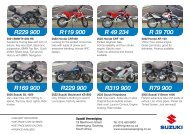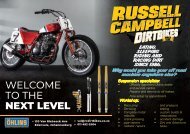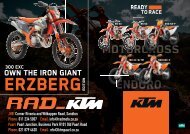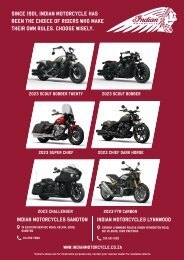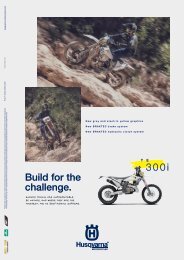You also want an ePaper? Increase the reach of your titles
YUMPU automatically turns print PDFs into web optimized ePapers that Google loves.
When the rotor is subjected to serious heat, it expands. By allowing it to float<br />
separately from the mounting face it is free to expand and shrink again at will<br />
without being constrained by its mounting. When this expansion takes place is<br />
does so in all directions at once and it will not be constrained.<br />
If you prevent this from happening in one direction (by fixing it on its mounting<br />
face) it has no choice but to warp, so floating discs and semi-floating discs are<br />
made in two parts to allow the discs to expand and prevent them from warping.<br />
These are a high performance type brake disc.<br />
Bikes of more moderate performance can use fixed brake discs perfectly<br />
happily and you will also see that most rear brake discs are fixed. This is because<br />
they don’t get used as hard and therefore subjected to as much heat.<br />
Even so, most rear brake discs are thicker than the front brake discs and<br />
this is a compromise because the cooling is not as good as the front discs.<br />
They don’t get as hot but don’t cool as well either, so the thicker material<br />
helps prevent them from warping.<br />
Ventilated brake discs:<br />
Possibly the most common type of disc, (more on cars than bikes), a<br />
cast design that sees the two ‘faces’ of the disc spaced apart, giving<br />
room for cooling channels which allow heat to escape, preventing the<br />
disc from getting too hot and cracking, while also increasing the life<br />
of the pads. Initially they featuring straight channels but they have<br />
evolved through the years to improve airflow.<br />
Drilled Brake discs:<br />
Under heavy braking or in race conditions gases and particles are released<br />
forming a layer that prevents the pad from touching the disc<br />
effectively. Holes drilled through the disc give the gases and particles<br />
an escape route with a positive spin off of reducing weight<br />
of the part. However, if not done correctly, this process can<br />
also compromise the structural integrity of the disc. The<br />
brake disc acts as a big heat sync and by drilling it full<br />
of holes means there’s less of it to dissipate the heat<br />
generated by the friction of braking. However, with<br />
the evolution of braking technology and materials<br />
modern brake pads use are not as gassy as<br />
their predecessors thus reducing the need<br />
for drilling and the discs are manufactured<br />
more than strong enough. Fracturing is an<br />
exceptionally rare occurrence.<br />
Slotted or Grooved brake discs:<br />
The slotted, or grooved design is<br />
another attempt to answer the<br />
same issue. Slots or grooves in the<br />
surface of the disc allow gases to<br />
escape with the additional benefit<br />
of the scraping action introduced<br />
by the slots assist with cleaning<br />
the pad as well as the edges of<br />
the grooves increasing friction,<br />
(albeit at the expense of increased<br />
pad wear), and stopping<br />
power. And just like drilled discs,<br />
they look pretty awesome.<br />
Wave brake discs:<br />
Wave discs have been around in<br />
the motorcycle world for years.<br />
Wave discs place the mass closer<br />
to the axle for reduced inertia,<br />
better heat dissipation and lower<br />
weight. They were originally developed<br />
for Motocross bikes; however<br />
they see use on road going motorcycles<br />
too.






